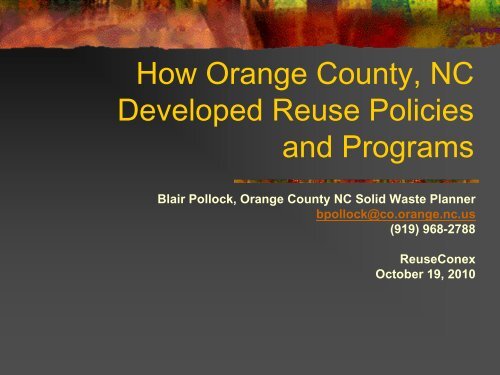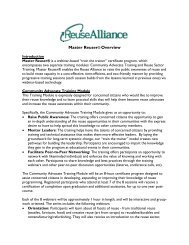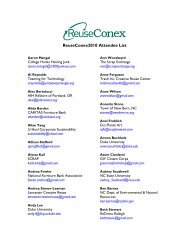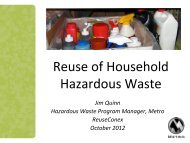How Orange County, NC Developed ReUse ... - Reuse Alliance
How Orange County, NC Developed ReUse ... - Reuse Alliance
How Orange County, NC Developed ReUse ... - Reuse Alliance
You also want an ePaper? Increase the reach of your titles
YUMPU automatically turns print PDFs into web optimized ePapers that Google loves.
<strong>How</strong> <strong>Orange</strong> <strong>County</strong>, <strong>NC</strong><br />
<strong>Developed</strong> <strong>Reuse</strong> Policies<br />
and Programs<br />
Blair Pollock, <strong>Orange</strong> <strong>County</strong> <strong>NC</strong> Solid Waste Planner<br />
bpollock@co.orange.nc.us<br />
(919) 968-2788<br />
<strong>Reuse</strong>Conex<br />
October 19, 2010
Recycling preceded <strong>Reuse</strong><br />
• <strong>County</strong> public programs recycling began in<br />
1987, first focus was on newspaper, glass and<br />
aluminum cans.<br />
• A robust but small reuse and repair sector<br />
existed led by PTA thrift shop in Carrboro and a<br />
variety of shoe, appliance and equipment repair<br />
& rental shops<br />
• No public sector involvement in <strong>Reuse</strong> initially.
<strong>Reuse</strong> began at Solid Waste Convenience<br />
Centers in “Salvage Sheds”<br />
• <strong>County</strong> converted from 19 unstaffed waste<br />
dropoff ‘green box’ sites – where scavenging<br />
and illegal dumping were rife – to six staffed<br />
sites in 1993.<br />
• Staffed sites were gradually equipped with<br />
salvage sheds aka swap shops modelled after<br />
the ‘In and Out House” –built by Sierra Club at<br />
an unstaffed recycling site in Asheville,<br />
• HISTORICAL NOTE: Salvage sheds were<br />
preceded by ‘Free Stores’ created by the<br />
Diggers in San Francisco and New York c.<br />
1966-67.
Salvage Sheds<br />
• These are ~20’x20’x10’h aluminum carport<br />
type pre-fabricated structures<br />
• We used the three sided model from Auto<br />
Boat Ports ~ $2,800<br />
• Installed over several years at 5 of the six<br />
SWCCs. (sixth site too small for one)<br />
• Very popular for both dropoff and pickup
Typical Monday at the Shed
Some are bringing, some are<br />
taking
Salvage Sheds<br />
• Formal policies evolved over time to:<br />
limit time for scavengers to 15 minutes twice a<br />
day,<br />
restrict scavenging by staff to end of day,<br />
prohibit stuffed furniture, clothing, glasses,<br />
construction materials, and<br />
allow staff discretion to disallow items they feel<br />
won’t ‘sell’<br />
NOTE: Scavenging prohibited from containers at SWCCs.
Policies for Using the Shed
The disclaimer
Problems with Salvage Sheds<br />
• Conflict between users over items,<br />
• Conflict between staff trying to run a site & users who<br />
are simply waiting for desirable items,<br />
• Conflict when users see staff taking items or are given<br />
‘gifts’ by site patrons,<br />
• Conflict when over eager-scavengers approach donors<br />
before they unload,<br />
• Conflict when the item in the truck is not really being<br />
donated but scavengers are reaching in,<br />
• Conflict between staff & donors over where questionable<br />
items should go………….<br />
• SO-- WHY BOTHER?
Salvage Sheds<br />
• They are very popular and well used<br />
• One study of weights of items one weekend<br />
showed that over 60 tons a year were diverted<br />
• People get items they need that thrift shops may<br />
not want or can no longer accept for resale.<br />
• E.g. Toys are now prohibited from thrift stores<br />
due to lead paint issues stemming from Chinese<br />
made toys but now extending to all toys…….
What Wood You Use?<br />
• In 2004 <strong>Orange</strong> <strong>County</strong> began<br />
deconstructing buildings by subcontract<br />
and saving lumber for future use<br />
• Four buildings were deconstructed<br />
including a training school, a 1910 and<br />
1940s farmhouses and 1970s brick ranch<br />
• Materials were inventoried, stacked and<br />
stored for future use.
Pete Hendricks led all four deconstructions. Pete at<br />
his piles, says, “This is the only way to manage used<br />
lumber, must be sorted, sized, stacked and saved.”
Some lumber was professionally graded but<br />
that didn’t help the building code officials or<br />
builders much<br />
• <strong>County</strong> hired Timber Products Inc. to visually grade<br />
framing lumber, would not stamp.<br />
• 6,000 BF graded for $1,200 = $0.20/bf<br />
• Southern Pine Inspection Bureau would not participate<br />
or accept grading.<br />
• Building inspectors and truss makers would not accept<br />
visually graded lumber Framing – they observed<br />
grading and liked the looks of the material.<br />
• Truss maker said thickness varied too much and could<br />
be too hard to fasten. Needed planing.<br />
• <strong>NC</strong> State University wanted $4,800 to structurally test<br />
120 pieces - $40/ea. or<br />
• $3,000 to test 60 pieces = $60/ea.
Wood with grade ‘mark’<br />
BUT not stamped.
Lumber used on <strong>County</strong> Utility<br />
Buildings at Regional Park
Structural use had to be ‘overbuilt” to meet<br />
code officials’ expectations and no use was<br />
allowed in occupied structures.
And then some
Wood was auctioned off too, on “GovDeals.com” A lot of effort<br />
for small return…….much was given away after auction to<br />
non-profits including Habitat for resale.
<strong>County</strong> Solid Waste Admin Bldg Entry, light structural use<br />
allowed; architect OK’d it. But note beam on left holding<br />
bigger load is [specified to be] virgin timber.
Interior uses for some structural<br />
framing
Detail of salvaged wood – patina & distressed<br />
look add some style and identity to the solid<br />
waste building
Scavenging at the C&D Landfill<br />
• 1997 – 2000, one full time employee with skid steer,<br />
• Started by scavenging reusables including doors,<br />
windows, fixtures,<br />
• Stored in tractor trailers with custom built roof over it,<br />
• Conducted two yard sales that ‘broke even’ used old<br />
mobile homes for more storage,<br />
• Donated materials to non-profits and schools after that,<br />
Built good network. Easier to manage than sales.<br />
• BUT: Recycling was higher diversion and focus on scrap<br />
metal & pallets (later all solid wood) to save landfill<br />
space.
Regulated Recyclable Materials<br />
Ordinance<br />
• Driven by the need for C&D landfill space<br />
• About 30% of C&D could be recycled –<br />
wood, metal, cardboard – based on<br />
several waste sorts.<br />
• The RRMO drove more private sector<br />
reuse and that’s what Grant will talk about<br />
next.







